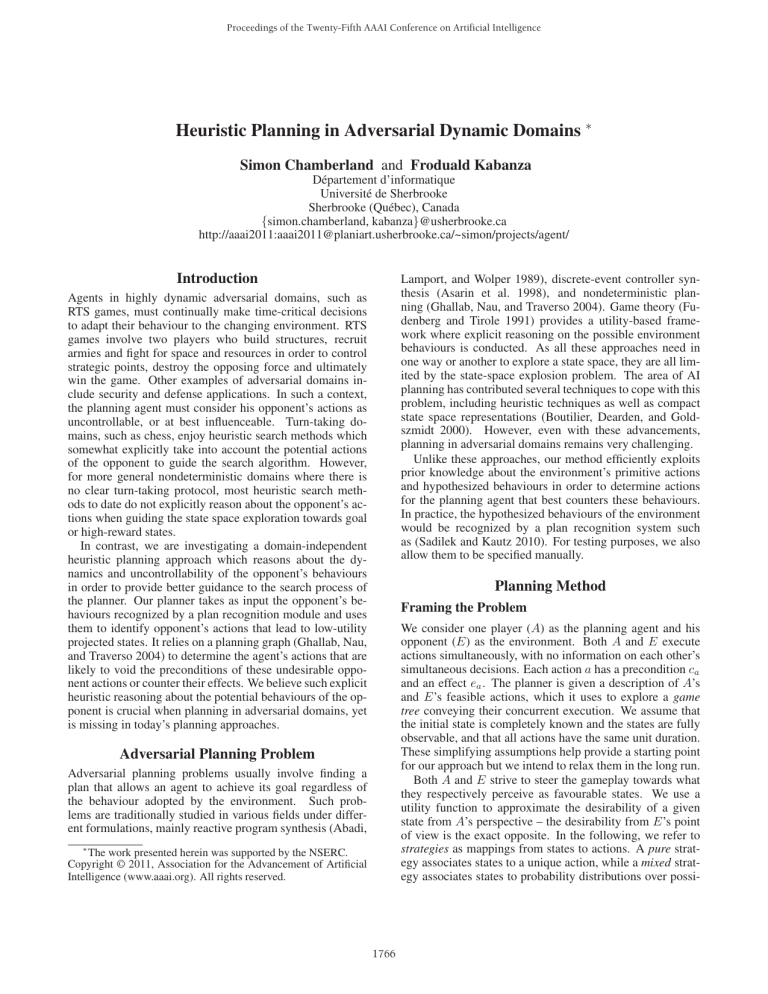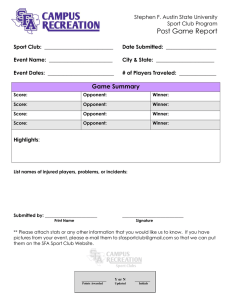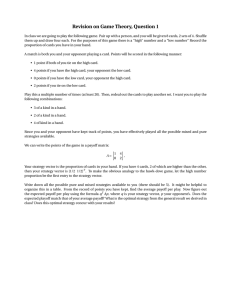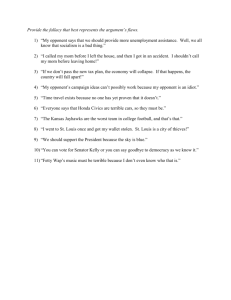
Proceedings of the Twenty-Fifth AAAI Conference on Artificial Intelligence
Heuristic Planning in Adversarial Dynamic Domains ∗
Simon Chamberland and Froduald Kabanza
Département d’informatique
Université de Sherbrooke
Sherbrooke (Québec), Canada
{simon.chamberland, kabanza}@usherbrooke.ca
http://aaai2011:aaai2011@planiart.usherbrooke.ca/~simon/projects/agent/
Introduction
Lamport, and Wolper 1989), discrete-event controller synthesis (Asarin et al. 1998), and nondeterministic planning (Ghallab, Nau, and Traverso 2004). Game theory (Fudenberg and Tirole 1991) provides a utility-based framework where explicit reasoning on the possible environment
behaviours is conducted. As all these approaches need in
one way or another to explore a state space, they are all limited by the state-space explosion problem. The area of AI
planning has contributed several techniques to cope with this
problem, including heuristic techniques as well as compact
state space representations (Boutilier, Dearden, and Goldszmidt 2000). However, even with these advancements,
planning in adversarial domains remains very challenging.
Unlike these approaches, our method efficiently exploits
prior knowledge about the environment’s primitive actions
and hypothesized behaviours in order to determine actions
for the planning agent that best counters these behaviours.
In practice, the hypothesized behaviours of the environment
would be recognized by a plan recognition system such
as (Sadilek and Kautz 2010). For testing purposes, we also
allow them to be specified manually.
Agents in highly dynamic adversarial domains, such as
RTS games, must continually make time-critical decisions
to adapt their behaviour to the changing environment. RTS
games involve two players who build structures, recruit
armies and fight for space and resources in order to control
strategic points, destroy the opposing force and ultimately
win the game. Other examples of adversarial domains include security and defense applications. In such a context,
the planning agent must consider his opponent’s actions as
uncontrollable, or at best influenceable. Turn-taking domains, such as chess, enjoy heuristic search methods which
somewhat explicitly take into account the potential actions
of the opponent to guide the search algorithm. However,
for more general nondeterministic domains where there is
no clear turn-taking protocol, most heuristic search methods to date do not explicitly reason about the opponent’s actions when guiding the state space exploration towards goal
or high-reward states.
In contrast, we are investigating a domain-independent
heuristic planning approach which reasons about the dynamics and uncontrollability of the opponent’s behaviours
in order to provide better guidance to the search process of
the planner. Our planner takes as input the opponent’s behaviours recognized by a plan recognition module and uses
them to identify opponent’s actions that lead to low-utility
projected states. It relies on a planning graph (Ghallab, Nau,
and Traverso 2004) to determine the agent’s actions that are
likely to void the preconditions of these undesirable opponent actions or counter their effects. We believe such explicit
heuristic reasoning about the potential behaviours of the opponent is crucial when planning in adversarial domains, yet
is missing in today’s planning approaches.
Planning Method
Framing the Problem
We consider one player (A) as the planning agent and his
opponent (E) as the environment. Both A and E execute
actions simultaneously, with no information on each other’s
simultaneous decisions. Each action a has a precondition ca
and an effect ea . The planner is given a description of A’s
and E’s feasible actions, which it uses to explore a game
tree conveying their concurrent execution. We assume that
the initial state is completely known and the states are fully
observable, and that all actions have the same unit duration.
These simplifying assumptions help provide a starting point
for our approach but we intend to relax them in the long run.
Both A and E strive to steer the gameplay towards what
they respectively perceive as favourable states. We use a
utility function to approximate the desirability of a given
state from A’s perspective – the desirability from E’s point
of view is the exact opposite. In the following, we refer to
strategies as mappings from states to actions. A pure strategy associates states to a unique action, while a mixed strategy associates states to probability distributions over possi-
Adversarial Planning Problem
Adversarial planning problems usually involve finding a
plan that allows an agent to achieve its goal regardless of
the behaviour adopted by the environment. Such problems are traditionally studied in various fields under different formulations, mainly reactive program synthesis (Abadi,
∗
The work presented herein was supported by the NSERC.
Copyright © 2011, Association for the Advancement of Artificial
Intelligence (www.aaai.org). All rights reserved.
1766
compares the utility of successive states – say s1 and s2 –
and marks a specific E’s action as undesirable whenever it
causes a utility loss greater than a certain threshold. Let a1
be such an undesirable action. When propagating the utility
value of s2 back to s1 , the algorithm also includes the undesirable actions that s1 may lead to – in this case, a1 – and the
time before which this action must be prevented. Regression
is performed on the undesirable actions’ preconditions to include prior actions on which they depend. For example, E
may have chosen action a0 in state s0 specifically to enable
action a1 in the next state s1 . This process yields, for each
state, a set of actions Act which the planning agent A aims
to prevent and the time at which they take place.
To generate alternative actions for A, we maintain a planning graph rooted at the initial state from which we extract
sequences of actions specifically chosen to falsify some undesirable action’s precondition. The main advantage provided by the planning graph is the guarantee that, given an
action a ∈ Act taking place at time t, the action a cannot
be prevented in time if level t of the planning graph is not
compatible with ¬ca .
ble actions. Formally, we formulate the problem as a twoplayer zero-sum simultaneous game where the objective is
to find a strategy maximizing A’s expected utility within the
alloted time frame. Our approach optionally takes as input
E’s behaviours recognized by a plan recognition module,
which specify a mixed strategy defined for a certain set of
states SE . The strategy might be based on a specific a priori model of the opponent – for example, attack behaviours
could be considered more probable when playing against an
aggressive opponent.
Main Algorithm
The planning approach algorithm is essentially an iterative deepening procedure exploring a limited subset of the
game tree and progressing further ahead until time runs out.
Within each iteration, the algorithm computes a strategy
based on the possible environment’s behaviours restricted
by the current time horizon. States s ∈ SE must only be
associated an appropriate action for A; these are states for
which we know E’s strategy. However, states s ∈
/ SE do not
contain any information about E’s actions; in these states a
suitable strategy for A must be found, given an assessment
of E’s strategy which must also be computed. E’s strategy
can be estimated using various opponent models. In our approach we combine the two models detailed below.
Conclusion
Adversarial planning problems form an important research
topic in many areas, yet remain very challenging to address
with recent planning methods. The approach we propose
tackles a new dimension of the problem which to the best of
our knowledge has not been examined so far. Moreover, it
also corresponds to how humans intuitively approach adversarial planning problems in practice: by pondering over their
possible options, given situations that they would like to prevent. Future work will aim to implement our approach in an
RTS-playing agent and relax the simplifying assumptions of
perfect information and actions having similar duration.
Worst-Case Opponent Model The worst-case opponent
model consists in assuming E chooses the best response to
A’s action choice – that is, the action inducing the greatest possible loss for A, given A’s action. Expanding states
with the worst-case opponent model can be achieved via
a simultaneous-move variant of the well-known alpha-beta
pruning algorithm. Since this model is not realistic, we use
it as a starting point for further refinement.
Nash Equilibrium Model We use the Nash equilibrium
model to adequately represent the agents’ lack of knowledge
about each other’s strategy. A set of strategies (in our case
A’s and E’s strategies) is in a Nash equilibrium when neither
agent has an incentive to unilaterally deviate from its current
strategy, given the other agents’ strategies. In a two-player
zero-sum setting, the equilibrium can be found by solving a
Linear Programming problem, whose complexity is polynomial in the number of actions. This yields a probability distribution over the possible actions. However, accurate computation of the equilibrium is too time-consuming for game
trees of reasonable size. We are considering sampling-based
approaches (Lanctot et al. 2009) converging to an -Nash
equilibrium, i.e. an approximation of the equilibrium with a
difference of in terms of expected utility.
References
Abadi, M.; Lamport, L.; and Wolper, P. 1989. Realizable
and unrealizable specifications of reactive systems. In Proc.
of the 16th Int. Colloquium on Automata, Languages and
Programming, LNCS Vol. 372, 1–17.
Asarin, E.; Maler, O.; Pnueli, A.; and J.Sifakis. 1998. Controller synthesis for timed automata. In IFAC conference on
System Structure and Control, 467–474.
Boutilier, C.; Dearden, R.; and Goldszmidt, M. 2000.
Stochastic dynamic programming with factored representations. Artificial Intelligence 121:49–107.
Fudenberg, D., and Tirole, J. 1991. Game Theory. MIT
Press.
Ghallab, M.; Nau, D.; and Traverso, P. 2004. Automated
Planning: Theory and Practice. Morgan Kaufmann.
Lanctot, M.; Waugh, K.; Zinkevich, M.; and Bowling, M.
2009. Monte Carlo sampling for regret minimization in extensive games. In Advances in Neural Information Processing Systems 22 (NIPS), 1078–1086.
Sadilek, A., and Kautz, H. 2010. Recognizing multi-agent
activities from GPS data. In Proceedings of the 24th Conference on Artificial Intelligence (AAAI).
Heuristics
The heuristics presented in this section are independent from
the opponent model used in the game tree expansion process; their purpose is to suggest beneficial actions for A that
will hopefully mitigate the future undesirable outcomes of
E’s estimated strategy.
Let s0 , s1 , and s2 denote successive states expanded by
the algorithm. When expanding the game tree, the algorithm
1767






